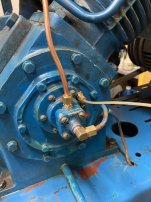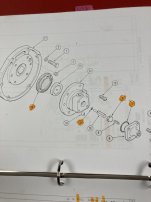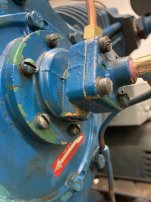RC Mech
Stainless
- Joined
- Jul 21, 2014
- Location
- Ontario, Canada
Just finished rebuilding a late-80’s Dresser-LeRoi 660A compressor. Machine was used a storage tank prior to our acquisition, valves in head were broken.
Rebuilt with new bottom-end bearings, crank bearings, piston rings and all gaskets etc. I’ve never heard it run prior to building a control box for it yesterday. Machined new unloader pistons as old units were worn.
Builds air, cuts out at 150 psi per my set points. Unloaders do not work. This is the unloader circuit:

These new copper lines follow the same config as the old. Unloader pistons are in the intake valve caps (duh).

Unloader circuit runs into this unit in front of the oil pump circuit. Plastic line is an oil pressure gauge. Line in front closest to us goes straight into the tank. Air leaks slowly but continuously from this port when pump is stationary:
When I plug this port solid, the unloaders are engaged via that “leaking” air pressure. The original plug has a 0.040” orifice in it, designed to leak. #18 on schematic below “plug, orifice for start-stop control only”.

I have no reference for how this is supposed to work. I imagine the unloaders should engage, pump gets to speed, disengage, pumps air. Right now the 10 hp 600V motor powers thru the start up, but then what’s the point of the unloaders right?
How do I plumb this correctly?
Rebuilt with new bottom-end bearings, crank bearings, piston rings and all gaskets etc. I’ve never heard it run prior to building a control box for it yesterday. Machined new unloader pistons as old units were worn.
Builds air, cuts out at 150 psi per my set points. Unloaders do not work. This is the unloader circuit:

These new copper lines follow the same config as the old. Unloader pistons are in the intake valve caps (duh).

Unloader circuit runs into this unit in front of the oil pump circuit. Plastic line is an oil pressure gauge. Line in front closest to us goes straight into the tank. Air leaks slowly but continuously from this port when pump is stationary:

When I plug this port solid, the unloaders are engaged via that “leaking” air pressure. The original plug has a 0.040” orifice in it, designed to leak. #18 on schematic below “plug, orifice for start-stop control only”.

I have no reference for how this is supposed to work. I imagine the unloaders should engage, pump gets to speed, disengage, pumps air. Right now the 10 hp 600V motor powers thru the start up, but then what’s the point of the unloaders right?
How do I plumb this correctly?



